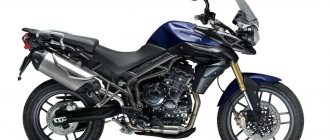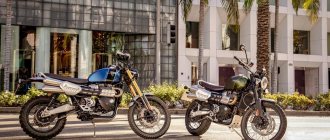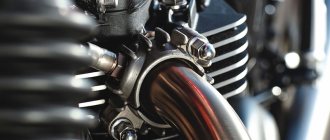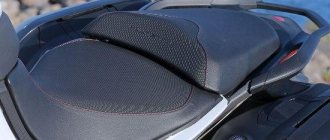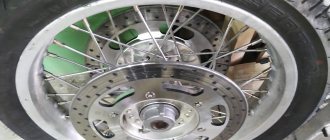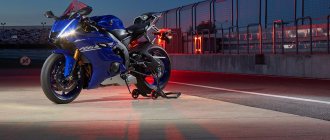2018 Triumph Tiger 1200 XCA Touring Motorcycle
New for 2021, the Triumph Tiger 1200 XCA aims to take on the BMW R1200GS Adventure. But, as they say, not every weapon is designed to win a battle. The new XCA model is very similar to another new addition to the Tiger line: the XRT. The off-road XCX model differs from the XR with spoked wheels, an additional Off-road mode, engine protection and an aluminum skid plate. I must say that this is a little disappointing, because the price has increased much more than these minor changes.
The Triumph Tiger 1200 XR just looks more brutal now.
As for BMW, the GS Adventure differs significantly from its market rivals thanks to its increased suspension travel and 30-litre fuel tank. For those who hate constantly interrupting their journey to fill up, such a large tank will be an argument in favor of buying a BMW. The Triumph Tiger 1200 XCA inherited the XR suspension with semi-active settings, and the tank volume, unfortunately, remained the same. When Triumph was asked the question “Why?” they responded that they simply did not want to develop a larger fuel tank as it would add weight to the bike and require more suspension travel, which would not meet customer requirements.
It’s strange, of course, but BMW’s sales level is a clear example of the fact that future owners of a touring motorcycle are willing to put up with bulkiness in favor of an increased power reserve and the ability to ride off-road. But Triumph management and designers made their choice, and they came up with a pretty good motorcycle, the XCA. The XC has exactly the same driver assistance systems as the road-going Tiger models. Plus, the XC's spoked wheels are shod with the same Metzeler tires as the XR. Although the manufacturer has approved the use of Pirelli Scorpion Rally racing tires, so you can switch to them if you wish.
The Triumph Tiger 1200 XCA performed very well on the gravel track. When you select the off-road mode, the ABS function is active only on the front wheel, so while the electronic system is working, the rear wheel has time to go into a slight skid.
The Triumph Tiger 1200 XCA motorcycle cannot be called light, because its dry weight is 248 kg. For inexperienced drivers, this can be a challenge in the absence of roads. The lack of vertical suspension travel has consequences: when jumping, you hit the ground with the crankcase protection, but it’s bearable. More experienced riders can select the Off-road pro mode, which disables the ABS and traction control systems. Unlike its rivals in the segment, the Triumph Tiger 1200 XCA looks more like a stylish trainer than a world conqueror. Although if you're into spoke wheels and easy trail riding, the XR is for you, with excellent take-off performance and a variety of electronic technologies.
Advantages of Triumph Tiger 1200 XCA:
- more than 100 modifications and improvements;
- 10 kg lighter compared to the outgoing model;
- lightweight flywheel and crankshaft;
- roll bars, spoked wheels, aluminum crankcase protection;
- electronic panel with TFT screen, advanced electronic systems, adaptive tilt light.
Features of the Scrambler 1200 XE
The XE version's saddle is 870mm above the ground. In this respect the car is closer to the Tiger 800 than to other Triumph models. At the front, Showa up-down forks (47mm leg diameter) are fully adjustable. On the other hand, the rear is focused classically, that is, on two shock absorbers from Öhlins. Like the fork, they are fully adjustable and have an ambitious 250mm of travel. Add to this the Pirelli Scorpion Rally tires on the 21-inch front rim and the wide steering wheel. The solid-looking skid plate also encourages you to take it off-road.
Fully adjustable suspensions can be used both on asphalt and in field conditions.
Brembo M50 four-piston calipers also work on our Triumph Street Triple RS motorcycle.
The position behind the controls is fine, height will be good here anyway (I'm 190cm tall). The stylish sofa is quite comfortable, and the wide steering wheel fits well in the hands and encourages an active posture. In turn, the narrow 16-liter fuel tank does not interfere with standing up. The only thing I would like to do is raise the handlebars a little and hide the tall exhaust (hide the knee on the cover).
A ride in the Scrambler 1200 will change the way you look at, if not the world, at least the immediate area.
Despite this, it is nice to wander around the area. Moreover, in one move you disable ABS and traction control (Off-Road Pro mode only in the XE version). I liked the predictable engine response, light clutch lever and good basic suspension tuning.
I was surprised by the ease of use and convenience. You will stop noticing the significant weight (228 kg with fuel) and the significant length of the car (wheelbase 1570 mm).
You can remove the rubber from the wide footrests at any time.
Both brakes are quite comfortable, but the front ones can be less harsh in the field. Fortunately, it's more of a habit. If you feel unsure off-road, you can select the off-road mode. Traction control then allows the rear end to skid, while ABS keeps the front end safe.
The fork dives deep initially but does so in a controlled manner and the ABS is very well tuned. Result? Very short braking distance from 100 km/h to zero – 39.4 m. At that moment, when Triumph had already stopped, the Ducati Scrambler 1100 only accelerated to 28.2 km/h.
Let's talk about the Triumph Tiger 1200 line.
The Tiger 1200 motorcycle comes in two forms: the road XR with alloy wheels and the sporty XC with spoke wheels. These two models then split into two more versions with different characteristics.
The Triumph Tiger XR comes in three specifications: Standard, X and T
The Triumph Tiger XR version comes with a digital instrument panel, semi-active suspension, traditional ABS and traction control systems, but lacks cruise control and an electrically adjustable windscreen.
The Triumph Tiger XRX comes with a TFT instrument panel, semi-active suspension, ABS and traction control with corner action, keyless ignition and an additional riding mode.
In addition, this model can be purchased with a low saddle, the height of which is 815 mm instead of the usual 835 mm.
The Triumph Tiger XRT version additionally features a bi-directional quickshifter, adaptive headlights, an Arrow muffler, hill start assist, heated grips and seat and another riding mode.
Not to be in trend: test drive Triumph Explorer XCx
Because a good motorcycle should not remain in the shadows, even if its sales in one particular country are handled not by a powerful representative office of a corporation, but by a small private company.
The war for the consumer in the main (and in this case, European) markets is serious, and the state of affairs in Russia here does not reflect global trends at all: there the market for large motorcycles for traveling on different roads with an engine capacity of around 1,200 “cc” is now - one of the most attractive to clients. Fashion, sir, you know. As is the case with the American UTV market, where the two main manufacturers from Canada and the USA are fighting for blood for every buyer.
In the world of "tourendur" things are no better. Or no worse? Today, a 1,200 cc all-terrain vehicle, stuffed with electronics, is in the line-up of all the world's leading brands, but all sorts of “Italians” and “Austrians” are one thing, and two giants are another: the German BMW, which actually came up with the philosophy of the “large SUV” and before still occupying a leading position, and the British Triumph, which does not want to give up its position and, moreover, has an equally rich and long history. The first Triumph was released in 1903!
1 / 5
2 / 5
3 / 5
4 / 5
5 / 5
The eternal desire of the islanders to oppose themselves to the entire continental Europe is also known. Therefore, although the British motorcycle is built according to all modern canons of the genre, it differs from its competitors in every way possible.
Three…
It just so happens that “real” touring enduros are always equipped with two-cylinder engines. BMW has a boxer engine, KTM, Ducati and Aprilia have V-shaped twins, and Yamaha has an inline engine. And this is where Triumph decided to show everyone that they have their own way. The Explorer 1200 is equipped with a traditional three-cylinder in-line engine for the brand.
It should be noted that the choice of “twos” for dual-purpose motorcycles is due to the fact that it is this design that most fully combines the convenience of power and torque control, good traction at low and medium speeds (which, of course, is needed off-road) and good power at tops, necessary for comfortable and relatively quick movement on good surfaces over long distances. One “pot” – it pulls well at the bottom, but is highly vibration-loaded, and a large volume has been ordered for “single-barrel” ones. “Fours” are too torquey and lack traction in the low rev range. The Triumph's three cylinders, being equidistant from both of these configurations, behave like four rather than two. In addition, the crankpins of the crankshaft are rotated relative to each other by equal 120 degrees, so that the engine produces a very even characteristic of thrust and power from bottom to top. Again, the more cylinders, the higher the speed you can spin the engine, which means more power can be produced. Here the tachometer red zone starts at an atypical enduro 10,000 rpm, and 139 “horses” are removed from 1,215 cm³. Let me remind you that the latest iteration of the BMW R1200 GS has 125 horsepower, and the Yamaha Super Tenere has 112.
Triumph Explorer XCx
Engine and transmission
Engine three-cylinder, in-line, liquid-cooled, 12 valves, DOHC, 1,215 cm³ Bore / stroke 85 mm / 71.4 mm Power 139 hp With. (102 kW) at 9,300 rpm Torque 123 Nm at 6,200 rpm Transmission 6 speeds Final drive driveshaft
And here the conclusion naturally creeps into one’s head that an honest competitor for the Explorer needs to be looked for in a slightly different camp – not among standard SUVs, but among crossovers. Well, what do we have here? Inline four from a sportbike, derated to a “modest” 160 hp. s., 17-inch road wheels and slightly increased ground clearance. Well, of course, it's a BMW S1000XR! Here you will have someone to compete with at the traffic lights! Or the KTM 1290 Super Adventure - the same 160 “horses”, plus spoked (well, off-road) wheels and completely asphalt tire sizes - 17 inches in the rear, 19 in the front.
Of course, in principle, all these motorcycles play in the same league. It’s just that some people need more “asphalt”, others need more off-road potential, although, of course, both of them leave the asphalt equally rarely. Our test subject ends up somewhere in the middle, with a noticeable advantage in the asphalt.
…plus electrification of the entire country
In terms of the number of electronics, Explorer is not inferior to any of the above “flagships”. Here there is everything that modern engineering has managed to come up with! The XCx configuration, as the most off-road of all, has three motorcycle operating modes - road, rain and off-road. The choice of one mode or another radically changes the operation of all systems of the device, from changing power and ignition maps to settings for the “strictness” of traction control, ABS and suspension stiffness. Within each mode, you can set personal settings for each motorcycle system - complete freedom of self-expression.
Triumph Explorer XCx
Chassis
Spatial tubular steel frame Single-sided aluminum pendulum with a cardan shaft in the body Wheels spoked wheel rims, aluminum rims, 32 spokes, for tubeless tires Front tire 120/70 R 19 Rear tire 170/60 R 17
Front suspension
Triumph Explorer XCx
WP inverted fork with electronic adjustment, stay diameter – 48 mm, travel – 190 mm
By the way, special mention should be made about the semi-active suspension. Triumph is equipped with perhaps the most sophisticated semi-active suspension today, TSAS (Triumph semi-active suspension). Even though it bears its “personal” name, it was created by the world leader in “suspension engineering” - the WP company (it also supplies suspensions for KTM). In addition to the fact that the pilot can set the range of operation (harder - softer), the suspension itself monitors its position and the speed of movement of the shock absorber rods several tens of times per second using built-in sensors and continuously adjusts certain hydraulic parameters.
In the complex task of providing complete control and security, other electronic components also interact - the accelerometer; sensors for motorcycle tilt, wheel angular speeds, throttle position and many others. From all this every second flow of information, the “brain” constantly, dynamically changes not only the suspension settings, but also all the main systems.
Rear suspension
Triumph Explorer XCx
WP monoshock absorber with electronic rebound adjustment and automatic spring preload adjustment, rear wheel travel – 193 mm
In a word, the diploma of “the safest motorcycle”, which last year I issued to the KTM 1290 Super Adventure, in 2016 can be safely photocopied and distributed to many others, including the Triumph Explorer.
Of course, if we have the “most off-road version” of the Explorer, it is equipped not only with spoked wheels, but also with “off-road” electronics. The off-road mode not only “tightens” the engine’s response to the throttle, making it smoother in operation, but also turns off the ABS of the rear wheel, allowing you to brake in a skid backwards. At the same time, the front wheel remains under the supervision of the “anti-block”, although not as strict as in asphalt modes. Traction control allows all sorts of liberties such as skidding turns and slipping, but within reasonable limits: so that it is fun and effective, but safe. In short, if necessary, you can safely drive the XCx beyond paved areas, especially if you change it into more “toothy” tires than the standard Metzeler Tourance Next, fortunately the tire size is standard for heavy enduro. The suspension travel - 190 in the front and 193 mm in the rear - is not much (about 1 cm) inferior to the KTM, and compared to the GS with its 190 mm in the front and 220 mm in the rear, the Explorer does not look like an outsider. But where the Explorer definitely beats all its competitors is its electric windshield. This solution itself has been used by many manufacturers for a long time, but this is the first time such a thing has been implemented on a large enduro. Even the ultimate GS Adventure has nothing to answer here!
distant battle
No matter where you look, no matter what motorcycle system you fit into, you are faced with the same options that you have already seen with both the “Germans” and the “Austrians,” and the “Italians” have also been in the subject for a long time. The Ducati Multistrada, which received an “off-road” Enduro version this year, is similar in its performance characteristics to its competitors. But even here, Triumph stands out from the crowd of its “classmates”: a “peppy” cohort with a power of 160 hp. With. turns out to be a little more powerful than him, and the guys of the “old school” are a little less powerful. Nevertheless, its 139 forces, divided between three cylinders, allow you to drive very quickly. The motorcycle strives to tear the front wheel off the asphalt even in third gear, with gas. There is a lot of power at medium speeds, even though the electronics keep both wheels firmly stuck to the asphalt. At the same time, the engine, as I already said, has a much more “four-cylinder” character than a “two-cylinder” one: it is very elastic and has a thick layer of power in the mid-speed range, without losing much at peak values.
All this makes the motorcycle very comfortable and fast on asphalt of any quality, and the spoked wheel rims mean you don’t have to worry too much about their safety. Again, the spokes are noticeably lighter than casting, which makes the Triumph very docile and nimble, despite the curb weight of 259 kg.
By the way, this is perhaps one of the most striking features of this motorcycle. The first thing you feel when you get behind the wheel is how easy it seems to drive. As if under you is not “two hundred liters”, but some kind of “eight hundred”! In city traffic, driving it is as easy and comfortable as driving some medium-sized road car. Of course, time does not stand still, and now this “lightness”, which we can’t get used to, is inherent in so many models, but the Yamaha Super Tenere cannot boast of such agility, and the KTM Super Adventure also turns out to be heavier and clumsy in subjective comparison.
Triumph Explorer XCx
Dimensions
Handlebar width 830 mm (930 mm with hand protection) Height (without mirrors) 1,400 mm Seat height 837 mm – 857 mm (Adjustable position) Wheelbase 1,520 mm Curb weight 259 kg Tank capacity 20 liters
It turns out that the Explorer, even in its most off-road adventure version, the XCx, turns out to be much more suitable for everyday life (as well as for long trips) than other competitors. But even if you put aside subjectivity and pick up a calculator, it will turn out even more interesting.
1 / 6
2 / 6
3 / 6
4 / 6
5 / 6
6 / 6
Triumph Explorer XCx is sold in a single configuration (except for the lowered version) at a price of 1,290,000 rubles. The cost of the main “enemy” - the BMW R1200GS in a similar configuration - fluctuates around 1,420,000, although the “empty” version without many electronic options can be found cheaper (traditionally for BMW, “empty” configurations exist only as a special order). However, as we have already found out, this device can be compared with both the “goose” and the more expensive S1000XR, although today it is offered more expensively – for 1,380,000 rubles. The KTM 1290 Super Adventure now costs 1,449,900 rubles, and the off-road version of the Ducati Multistrada Enduro will cost 1,781,455 rubles. The only thing cheaper than the Explorer is the Yamaha Super Tenere, which is offered for 1,199,205 rubles, but in all respects it seriously lags behind all the motorcycles listed above. Still, having been released back in 2010, it is a motorcycle of the previous generation, and even a relatively deep modernization did not help it much.
So, in addition to the unique three-cylinder engine and best-in-class ease of operation, the Triumph Explorer XCx can also boast the best-in-class price with an equal degree of “staffing”. And, of course, returning to our realities, this device is an excellent way to stand out from the mass of “geese”, “superadventures” and other “superteners” that have already become familiar. Allowing yourself to be out of trend while remaining in the mainstream is cool.
